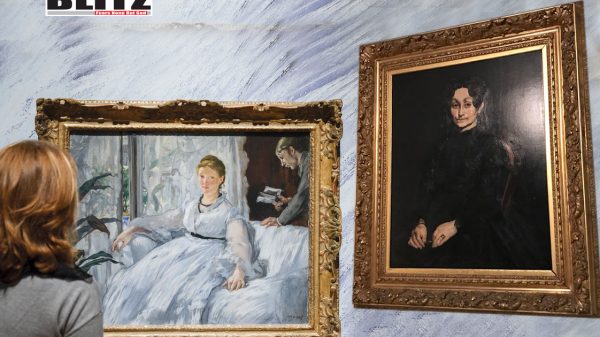Édouard Manet at the Isabella Stuart Gardner Museum
- Update Time : Thursday, January 16, 2025

The subject of the paintings included in Manet: A Model Family, on view at Boston’s Isabella Stuart Gardner Museum, would ostensibly be the members of the painter’s family. The true subject of Édouard Manet’s paintings is of course painting itself – in the sense that if his work does anything, it insists that painting must henceforth engage with its own preconditions. As Michel Foucault would observe, Manet begins a ceaseless movement ‘by which each rule that is posed, or each rule that is deduced, induced or inferred from each of the preceding acts, finds itself rejected and refused by the following act.’ This is the essential reason why Manet is regarded as the founder of modern art by such figures as Foucault and Clement Greenberg, among others – because he inaugurates a revolution in painting, one which does more than pave the way for the Impressionists (which is habitually noted), but in fact can be seen as the forerunner of Abstract Expressionism (just as often overlooked).
Manet frequently used the members of his close-knit family as models – including his wife Suzanne, her son Léon (of whom he or may not have been the biological father), his own mother and father, and the great painter Berthe Morisot, who would become his sister-in-law when she married his younger brother Eugéne. But they were ultimately models, to be used in ways that allowed the artist to reckon with the old masters while consciously breaking away from the tradition of those same painters which he idolized, such as Velásquez, Goya and the greatest of the Flemish painters, Peter Paul Rubens. Manet heeded Eugène Delacroix’s advice to “look at Rubens, draw inspiration from Rubens, copy Rubens. Rubens was God.” And we can see Manet paying Rubens direct homage in paintings such as Fishing (1862-63), which was lent to the Gardner by the Metropolitan Museum of Art. For color, composition and variety there is no painting on view to match this work which Manet painted as a wedding gift to his soon-to-be wife, Suzanne Leenhoff. While the two stand together at the lower right dressed in seventeenth-century costume, posed like Rubens and his wife in the Flemish painter’s Park of the Château de Steen (1635), their son Léon can be seen, fishing rod in hand, on the far end of the stream.
Even as Manet chafed at academic training, he immersed himself in the work of his great predecessors; and as we know from an 1865 letter to Henri Fantin-Latour, Manet was thoroughly “enchanted” by the portraits painted by Velásquez, which he regarded as nothing less than masterpieces one and all. I cannot help but be reminded of Charlie Parker’s relationship to the saxophonist Lester Young, whose playing he revered so much so that he learned his solos note-for-note, only to go on to create a musical language and vocabulary (i.e. bebop) which could only be regarded as semi-hostile to his musical idol. The comparison is I believe an instructive one and, in fact, one can see the artistic revolution that occurs, in both cases, as a kind of patricide, harsh as that may sound. The musical analogy holds up when we consider that, as the French painter Jacques-Émile Blanche noted, Manet (again not unlike the bebop revolution) made use of ‘unexpected chromatic harmonies… which to a concert audience seem discordant until the moment when the “dissonance” which has been hurting their ears suddenly affords more musical pleasure than a perfect chord.’ Even when he is quoting his predecessors, he is also subverting them, implicating the viewer in a way that is unsettling and dispenses with predictable notions of beauty.
Manet is incessantly referencing the old masters, yet never simply incorporating or quoting them when doing so, but also repudiating certain traditional aesthetic practices, in his apparently stark handling of light for example, or in the stridency of his brushwork, which comes increasingly to the fore as his work develops. We feel the movement of his brush, which gives his paintings a vitality and dynamism as if they are taking form before our eyes. If Manet was indeed the Immanuel Kant of painting (as Clement Greenberg remarked) it is because he knows that we do not see the world as it is but as we are. He learns from Delacroix to allow for the spontaneity of the viewer, without whom the work of art cannot become an aesthetic object as such. A painting that is completely finished is also completely dead. Hence, as the poet Stéphane Mallarmé wrote, ‘Manet followed… a divergent course. Seeking the truth and loving it when found, because being true it was so strange, especially compared with the old and worn-out ideals of it.’
The first major work of the exhibition consists of a double portrait of his parents, Monsieur and Madame Auguste Manet (1860), painted when his father, a jurist and chevalier of the Legion of Honor (marked by a dash of red on his lapel), was effectively incapacitated due to late-stage syphilis – the same disease that would take the painter’s own life at the age of fifty-one. It is a magisterial work; accepted for the Paris Salon of 1861, it also brought Manet his first official recognition. The observation of a contemporary critic is telling: ‘Manet tramples even the holiest ties. The Artist’s Parents must have cursed more than once the day a brush was put into the hands of this unfeeling portraitist.’ What the infuriated critics got right is that Manet is not interested in beautifying or flattering his subjects: his seated father is portrayed with appropriate gravitas, his gaze (like his wife’s) is fixed downward, his right hand clenched into what could be taken for a sign of judicial sternness but was more likely the result of paralysis. Behind him, stands his wife and caretaker, holding a mending basket, which along with the light blue ribbon draped over her shoulder allows for the introduction of color to brighten what is otherwise a somber, and contemplative work.
One of the most striking paintings on display is Berthe Morisot with a Muff (1868-69), and one immediately recognizes that a very different and even more daring painter has emerged in the intervening years. Manet never worked without his model present, and Morisot remarked that she had known Manet to rework a canvas twenty-five times to achieve an effect that in the end appeared effortless. That is what he has accomplished here, with a profile in which he highlights the contrast between the paleness of her face and her raven black hair, atop which rests an elaborate hat with white feathery flourishes. The true distinction of this canvas however lies in the brushwork, which appears sketchy, loose, almost unfinished; and yet there is nothing lacking. The painting lives and breathes, every stroke of the brush is animated and unforced. The result is a work that does justice to Morisot’s confidence, beauty and grace. For this writer it is simply impossible to praise this painting too highly, a work which might have been finished this morning, and reminds why us why Manet is not merely the father of Impressionism, but an artist who transcends time altogether. There has been much speculation regarding what, if any, romantic relationship existed between Morisot and Manet: when standing before this work it is difficult not to imagine there must have been something of the nature between the two, both painters of extraordinary power. What cannot be doubted is Manet’s love of painting itself – indeed, of paint, its materiality: he is obsessed with his medium, not his subject. As he would remark in 1882: ‘One isn’t a painter if one doesn’t love painting more than anything else in the world…’
It is worth noting that the exhibition also graciously includes one painting by Berthe Morisot herself, Fillette en mauve (1883), a portrait of her daughter, Julie who she used as a model in dozens of works. One can immediately appreciate the influence of Manet, as well as the significant contrast between the two painters. Morisot’s brushwork is thoroughly impressionistic, having absorbed the innovations not only of Manet, but others among her great contemporaries, including Claude Monet. The four-year old girl demurely peering out from the canvas is almost glowing, swathed in pale shades of purple, with light blues and greens in the background, as though she may be seated before a mossy pond. It is not the palette that we would associate with Manet, steeped as he was in the darker tones of the old masters, such as Rembrandt and Goya.
Perhaps the single greatest virtue of this exhibition is that, although it is not large, it still allows us to see Manet’s development as an artist, to trace his movement towards a new mode not simply of painting, but of seeing. One can hardly overestimate the significance of this achievement, which is indeed the mandate of a painter – that is, to enable is to see the world anew, to educate and fashion our sensibility by magically giving life to dead matter on canvas. It is hard for us to today to appreciate the hostility that Manet’s work aroused when such paintings as his Olympia (1863) were first presented before the public. Guards had to be placed around his work to prevent some violent attack upon the painting as it hung on the walls of the salon. Yet what grater tribute to an artist could there be? We do well to remind ourselves that art is not here to make us feel comfortable, safe or self-satisfied. If Manet is the founder of modern of art it is not because he was the first to dispense with the demand for producing beautiful images, but because he is perhaps the first to make explicit that beauty as such is only one aspect of aesthetic experience, and not necessarily its most important.
One way we may begin to truly recapture the significance of Édouard Manet is through what the extraordinary contemporary Romanian painter, Adrian Ghenie has called ‘hooliganism.’ What Ghenie is referring to with this term is the brazen subversiveness of the greatest painters, explicitly including the Impressionists and such seemingly harmless artists as Claude Monet but going back at least as far as Caravaggio when he had the unheard-of audacity to depict his poor pilgrims with dirt on the soles of their feet. Although Ghenie does not mention Manet by name, I have no doubt that he would agree that there is no painter who is more exemplary of hooliganism in this sense. Such painters are seeking truth and would not dare to sacrifice truth to mere beauty in the conventional sense. For these ‘hooligans’ the only real beauty worthy of the name is to be found in truth – in looking, really looking at the world, and daring the viewer as if to say: Here! Do not turn away. Find the beauty in this, in what your tired conventions deem ugliness. Love the world for what it is, in all its messiness, even in its lowest depths. Though not included in the exhibition, forget not Manet’s Absinthe Drinker (1859), for example. I would just add that it is here, if nowhere else that the artist and the philosopher can and should join hands: for as Plato would observe in his Parmenides, nothing is beneath the philosopher’s attentive gaze. The world may scoff, deride or do worse. Let them. In the end, Truth prevails.

















Leave a Reply